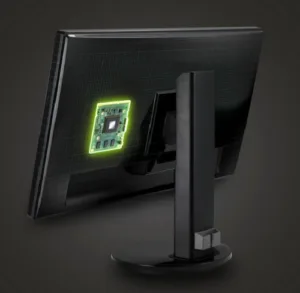Nvidia has shared a whole host of new products that will support its G-Sync technology at Computex 2015, in Taiwan. There are no fewer than six laptops and seven monitors with G-Sync built in that will be making an appearance on the market over the coming months.
Laptops will include Asus’ 17.3″ G751; MSI’s 17.3″ GT272G; Clevo’s 17.3″ P7707M-G; and Gigabyte’s 17.3″ Aorus X7; all of these will have 1920 x 1080 resolution. Clevo will also produce the P750ZM-G (15.6″ UltraHD), and Gigabyte will release the 15.6″ Aorus X5, which was announced at CES this year (Gigabyte Focuses on Displays in Premium Gaming Laptops).
All of the above laptops use new 75Hz panels, rather than the more traditional 60Hz units. Nvidia has said that it works very closely with vendors wanting to make G-Sync displays. It has the power of veto over any display panel that it feels is not worthy of bearing the brand.
Nvidia’s approval of each panel gives it greater control over the displays using G-Sync. This means that it can compensate for display-specific issues such as blurring, the company says, using the G-Sync module (this is only used in monitors, to replace the scaler; laptops do not require it as the GPU is connected directly to the display). In addition, Nvidia says that G-Sync compensates for frame rates below the monitor’s refresh rate, by doubling the refresh rate and inserting duplicate frames (PCPer has an analysis of the technology here: http://tinyurl.com/ogfxvqu).
In monitors, Acer and Asus will make all of the new units. The Acer units are:
- XB271HK: 27″ UltraHD, 60Hz, IPS
- XB281HK: 28″ UltraHD, 60Hz, TN
- X34: 34″, curved, 3440 x 1440, 75Hz, IPS
- Z35: 35″, curved, 2560 x 1080, 144Hz, VA
Asus has made three monitors. See Asus Focuses on Colour at Computex for more information on some of these models:
- PG279Q: 27″, 2560 x 1440, 144Hz, IPS
- PG27AQ: 27″ UltraHD, 60Hz, IPS
- PG34Q: 24″, 3440 x 1440, 60Hz, IPS.
Nvidia has also announced that G-Sync will be able to be used in windowed applications. Beforehand, it was limited to full screen use. In windowed mode, G-Sync will work with two-way SLI configurations (but nothing higher), and enabled/disabled on a per-application basis.
VR is often talked about as gaming’s Next Big Thing, and Nvidia is already working in the space. The company is boosting its presence with a new feature called Multi-Resolution Shading, to improve VR performance. It is part of Nvidia’s (also new) Gameworks VR brand, which brings together all of the company’s VR developer tools.
Challenges for VR include the need to warp images, to match the display’s fisheye optics (these help users focus on displays that are very close to their eyes). An image that is rendered on a conventional display, then cropped to match the viewing field, will have excess pixels rendered that are never shown. Additionally, the edges of an image can have unnecessary detail, which is not taken in by the human eye.
Nvidia’s technology sub-divides an image between the high-detail centre and low-detail periphery. The peripheral image is scaled to lower resolutions, while the centre is rendered at full resolution The end result is an image composed of fewer pixels – which is faster to render than a full-rendered image.
Nvidia claims that this approach improves shader performance by between 30% and 100%, depending on the game and scene.

